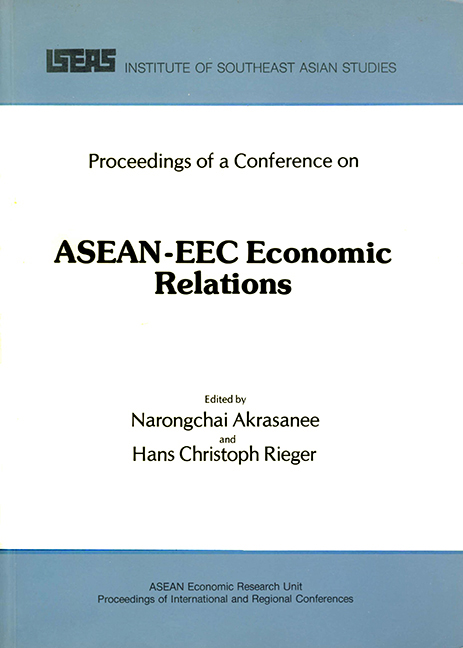Book contents
- Frontmatter
- Contents
- FOREWORD
- BUILDING BRIDGES AND OPENING DOORS
- 1 TRADE
- ASEAN-EC Trade Relations: An Overview
- Trends of EC Protection and the Prospects of ASEAN Trade
- Issues Relating to the EC's Imports of ASEAN Primary Products
- ASEAN Manufactured Exports in the EC Markets: An Empirical Assessment of Common and National Tariff and Non-Tariff Barriers Confronting Them
- A Constant-Market-Shares Analysis of ASEAN Manufactured Exports to the EC
- II INVESTMENT
- APPENDICES
ASEAN Manufactured Exports in the EC Markets: An Empirical Assessment of Common and National Tariff and Non-Tariff Barriers Confronting Them
from 1 - TRADE
Published online by Cambridge University Press: 21 October 2015
- Frontmatter
- Contents
- FOREWORD
- BUILDING BRIDGES AND OPENING DOORS
- 1 TRADE
- ASEAN-EC Trade Relations: An Overview
- Trends of EC Protection and the Prospects of ASEAN Trade
- Issues Relating to the EC's Imports of ASEAN Primary Products
- ASEAN Manufactured Exports in the EC Markets: An Empirical Assessment of Common and National Tariff and Non-Tariff Barriers Confronting Them
- A Constant-Market-Shares Analysis of ASEAN Manufactured Exports to the EC
- II INVESTMENT
- APPENDICES
Summary
PROBLEM SETTING
Till the end of the sixties ASEAN-EC trade relations exhibited the pattern of a traditional division of labour between primary commodity suppliers from less developed countries (LDCs) and manufactured goods suppliers from developed countries (DCs). The 1973 energy price shock and the ensuing discussion on primary commodity cartels and commodity agreements within a New International Economic Order could theoretically have induced the EC to perpetuate this pattern by institutionalizing its trade relations with ASEAN under the major objective of a safe access to input markets in primary commodities. However, an EC trade policy confined to this sole aspect would have been misleading against the background of a rapid sectoral change in the ASEAN exports flows to the EC during the last decade. Within nine years (1968-77) the ASEAN countries doubled the share of semi-manufactures and manufactures in their exports to the EC from about 25 per cent to more than 50 per cent. To a great extent this may have been the outcome of an export-oriented industrialization policy pursued in most of the ASEAN economies and assisted by other “environmental” export stimulants, such as the elimination of undervaluation of some EC currencies with its positive impact on “footloose” EC investments in ASEAN countries, aggressive wage policies of EC trade unions, as well as a world-wide lowering of tariff barriers due to the multilateral GATT negotiations on tariff rate harmonizations.
Apart from the supply-oriented policies and the “environmental” changes, the obvious trend towards a new intra-manufactures division of labour between the aging EC economies and the newly industrialized ASEAN countries have also been affected by specific EC trade policies in manufactures towards LDCs (ACP and Mediterranean countries) in particular. However, these policies starting from the early seventies, not only encompassed trade-stimulating components (such as non-reciprocal tariff cuts within the scheme of the Generalized System of Preferences (GSP) but also gradually incorporated selective non-tariff barriers (NTBs) in the same measure as some LDCs proved to be highly competitive in various branches.
- Type
- Chapter
- Information
- ASEAN-EEC Economic Relations , pp. 125 - 193Publisher: ISEAS–Yusof Ishak InstitutePrint publication year: 1981



